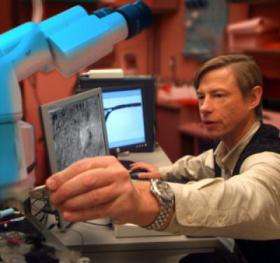Slices of living brain tissue are helping scientists identify new stroke therapies

Slices of living human brain tissue are helping scientists learn which drugs can block the waves of death that engulf and engorge brain cells following a stroke.
It's called anoxic depolarization and it primarily results from the brain getting insufficient blood and oxygen after a stroke, says Dr. Sergei Kirov, neuroscientist in the Medical College of Georgia Schools of Medicine and Graduate Studies.
The brain uses about 20 percent of the body's total energy and about half of that is needed to run the pump that maintains healthy levels of sodium and potassium in and around brain cells. A stroke takes away the pump's fuel, called ATP, so neurons and supportive astroglial cells quickly become bloated and dysfunctional. Cells die if the pumps don't start working soon, Dr. Kirov says.
Resulting waves are responsible for much of the immediate brain cell death in the core of a stroke. Milder waves may continue to pound contiguous areas for hours or days, potentially increasing stroke size and damage. In this area called the penumbra, cells get a little more oxygen so there is the potential for recovery if the waves can be silenced, he says.
Dr. Kirov has been examining whether several drugs can stop the pounding of the penumbra in an animal model and has completed a small pilot study in human tissue. The scientist, who directs MCG's Human Brain Laboratory, recently received a second grant from the National Institute of Neurological Disorders and Stroke to focus on the drugs' potential in human tissue. "We only have one approved drug therapy for stroke and new approaches are needed to improve treatment for the third leading cause of death in western countries," he says. He and others believe a focus on human tissue will better identify therapies that have real clinical merit.
A special report in the Nov. 29, 2007 issue of Stroke noted the failure in humans of numerous stroke therapies that looked promising in animal studies and outlined a new road map that includes better proof of efficacy in animal models as well as studies in human brain tissue focusing on the penumbra.
Dr. Kirov agrees. "Human brain slices as a model system can provide a missing link between animal models and patients and offer a unique chance to identify and study potentially useful therapeutics."
He is getting live images of glowing human neurons or astroglial cells to look first at the simulated stroke and then at what protection different drugs provide. The tissue is removed primarily during epilepsy surgery at MCGHealth Medical Center and Children's Medical Center. He replicates a stroke in the tissue by withholding oxygen and glucose then measures whether drugs can block anoxic depolarization.
There is plenty of living proof that cells can recover if the waves are short term: that's essentially what happens in migraines. "Some people describe these moving through their visual field: a wave silencing, but not killing, the neurons," Dr. Kirov says. Precisely what starts the wave remains an unanswered question. But he thinks he may be able to help delay or prevent the destructive electrical activity they bring without depressing usual central nervous system action.
He's testing dibucaine, a local anesthetic known to impact ion channels, which regulate the flow of negatively and positively charged molecules in and out of cells. Positively charged potassium, for example, normally leaks out through ion channels. With anoxic depolarization, there's too much sodium and too little potassium inside cells. He's also studying two sigma receptor ligands, dextromethorphan and carbetapentane.
Sigma receptors are ubiquitous in the body, but little is known about their role and what naturally activates them. Recent research suggests sigma receptors help protect cells from stress by ensuring an adequate level of the properly folded proteins they need for normal function. MCG Retinal Biologist Sylvia Smith and others have shown that sigma receptors are located within the endoplasmic reticulum of cells, which controls protein synthesis and regulates calcium levels. When needed, the receptors appear to chaperone these proteins to the cell powerhouse, or mitochondria. In his studies, Dr. Kirov is testing to see whether these sigma receptor ligands inhibit anoxic depolarization in humans to forecast translational success.
Source: Medical College of Georgia





















